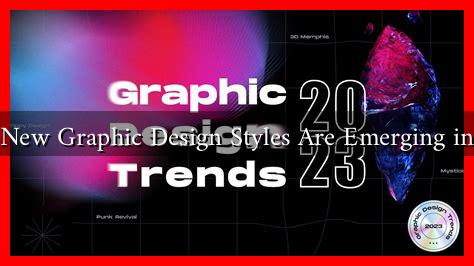-
Table of Contents
What New Graphic Design Styles Are Emerging in 2023
As we delve into 2023, the graphic design landscape is evolving at an unprecedented pace. With advancements in technology, shifts in consumer behavior, and the influence of global events, new styles are emerging that reflect the zeitgeist of our times. This article explores the most notable graphic design trends of 2023, providing insights into their origins, applications, and future potential.
The Rise of Minimalist Maximalism
In stark contrast to the minimalist designs that dominated the previous decade, 2023 has seen the emergence of “minimalist maximalism.” This style combines the clean lines and simplicity of minimalism with bold colors, intricate patterns, and layered textures. Designers are embracing a more eclectic approach, allowing for a mix of elements that create visual interest without overwhelming the viewer.
- Color Palettes: Bright, saturated colors are often paired with neutral backgrounds to create a striking contrast.
- Layering: Multiple design elements are layered to create depth, often incorporating typography, illustrations, and photography.
- Personalization: Brands are using this style to convey their unique identity, making designs feel more personal and relatable.
For example, the rebranding of the popular beverage company, Fanta, showcases this trend. Their new packaging features vibrant colors and playful typography, reflecting a youthful and energetic brand image.
3D and Immersive Design
With the rise of augmented reality (AR) and virtual reality (VR), 3D design has become increasingly prevalent in graphic design. Designers are leveraging these technologies to create immersive experiences that engage users on a deeper level.
- Interactive Elements: Brands are incorporating 3D elements into their websites and marketing materials, allowing users to interact with products in a virtual space.
- Realism: Advances in rendering technology have made it possible to create hyper-realistic 3D graphics that captivate audiences.
- Storytelling: 3D design is being used to tell stories in a more engaging way, allowing users to explore narratives through interactive visuals.
A notable example is the launch of IKEA’s AR app, which allows customers to visualize furniture in their own homes before making a purchase. This innovative approach not only enhances the shopping experience but also reduces the likelihood of returns.
Retro Futurism
As nostalgia continues to influence design trends, retro futurism has made a significant comeback in 2023. This style blends elements from past decades with futuristic concepts, creating a unique aesthetic that resonates with a wide audience.
- Visual Elements: Designers are incorporating vintage typography, color schemes, and graphic motifs reminiscent of the 70s, 80s, and 90s.
- Technology Integration: Retro futurism often features futuristic technology depicted in a nostalgic way, such as old-school robots or vintage sci-fi imagery.
- Emotional Connection: This style evokes feelings of nostalgia while simultaneously looking forward, creating a bridge between past and future.
Brands like Coca-Cola have embraced retro futurism in their marketing campaigns, using vintage-inspired graphics to evoke a sense of nostalgia while promoting modern products.
Sustainability in Design
As environmental concerns continue to rise, sustainability has become a crucial aspect of graphic design in 2023. Designers are increasingly focusing on eco-friendly practices and materials, reflecting a commitment to sustainability in their work.
- Eco-Friendly Materials: Brands are opting for sustainable materials in packaging and print design, such as recycled paper and biodegradable inks.
- Minimal Waste: Designers are adopting practices that minimize waste, such as digital-first approaches and efficient production methods.
- Conscious Messaging: Graphic design is being used to promote sustainability messages, encouraging consumers to make environmentally friendly choices.
For instance, the rebranding of the outdoor clothing company Patagonia emphasizes sustainability through its use of recycled materials and messaging that highlights environmental responsibility.
Conclusion
As we navigate through 2023, the graphic design landscape is rich with innovation and creativity. The emergence of styles such as minimalist maximalism, 3D and immersive design, retro futurism, and sustainability reflects a dynamic interplay between technology, culture, and consumer values. Designers are not only creating visually appealing work but are also addressing deeper societal issues, making their designs more relevant than ever.
As these trends continue to evolve, it will be fascinating to see how they shape the future of graphic design. For those looking to stay ahead in this ever-changing field, embracing these emerging styles will be essential for creating impactful and meaningful designs.
For more insights into graphic design trends, visit Creative Bloq.


